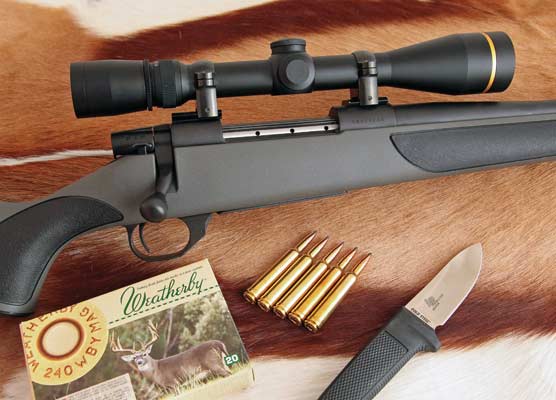| Gear |
0
For the multitude of hunters, having an expensive scope is not called for. If the glass is OK, the point of aim is reliable and the distance is less than 300 yards, they will be successful. Granted, it is cool to own a $2,000 to $3,500 scope, but is it necessary?
I was born and raised in a very small community in the Rocky Mountains. The place was surrounded by mountains. A 3-minute ride and you were already climbing, all the way to 12,000+ feet. No one dreamed of the Internet, smart phones, or even TV. The stores did not carry guns and only a small amount of ammo for a couple of popular rounds, mainly .30-30 and .30-06. There were 6 boys on the basketball team, which happened to be the entire senior class.
When the potato harvest and the deer hunt came around, the schools and most everything else closed down. Why not? There would not be any teachers in town anyway when deer season opened. There was also a week when everyone pitched in to bring in the harvests. People grew up on potatoes, gravy and venison.
When I was just a young poke, I ordered a Husqvarna .30-06 out of a catalog and mounted a Weaver 4X with very thin crosshairs and a dot. I took a lot of deer with that combo. A few years later, I purchased a Remington 700 in .264 Magnum, which had become the rage around town. I bought another Weaver with a bit more power and this time a variable.
Weaver, as the years went by, fell on hard times and many catalogs were selling the last of their steel scopes for peanuts. I bought one and hunted with it for years. But one journey along the slope of a hill, and one wrong step on a rock, saw me falling some distance. Sure enough, there was a large dent about where the erector tube sits. I had to resight-in the rifle, but still hunted with it for years.
Years continued to go by. The military took four of them, and college another several. I had gotten into pistol competition and benchrest. I remember a fellow showed up at a benchrest competition and began querying the shooters. “I spent years building Weaver scopes,” he said. He asked, “If I could build one that would not change point of impact, how much would you pay for it?” We laughed at the suggestion. Anyone would pay dearly for such a scope. A few years later Weaver began to appear again.
Needless to say, I still harbor affection for the Weaver scope. Yes, I have gotten into much more expensive scopes and write about them often. As a long-range hunter and competitor, as well as a glass lover, I veered in other directions, and my wallet got smaller. But the average hunter does not need a $3,000 scope. Most hunters still like to stalk their game and only shoot 250 yards or a bit more. Weaver scopes from the Super Slam to the V-series, cost from about $300 to $1,000, depending on your application. And they will do the job superbly.
Weaver’s Grand Slam 4-16x44mm is short and lightweight, here
shown on Browning’s new AB3 7mm Remington Magnum.
Weaver was nice enough to send along their Grand Slam 4-16x44mm for testing and evaluation. While Weaver still carries the K series, which looks strikingly similar to the first scope I ever owned, which was also a K series, and if memory serves me correctly, called a K4, they now make a 30mm body and several reticle varieties. The Grand Slam, however, still comes with a 1-inch tube, remains relatively short and light, and the variable-power cylinder takes a huge departure from earlier models.
The Grand Slam departs in several other ways from the old Weaver variable I owned. It has a European fast focus ocular and parallax adjustment. The reticle is a huge jump from my old thin reticle and dot. Although the turrets still say one click is 1/4-inch at 100 yards, the specs on Weaver’s website call that MOA. However, 1 MOA = 1.047 inches at 100 yards. While that is not a problem when shooting at the shorter ranges, it is a 5-percent difference, and surely makes a difference for very long-range shooters. It would be nice if they would correct that. But in reality, the best way to ensure the value of each click or hashmark is to do it on the range.
Weaver sent along some of their 1-inch rings mounting on a rail as I was planning to mount it on an accurate .308 and hit the range. About that time, one of Browning’s new AB3 7mm Remington Magnum bolt action rifles (see my test of the rifle in this issue) showed up for testing with rings included. It was the perfect application.
The turrets are capped, but when removed they are clearly marked in 1/4-inch
increment come-ups. This model also has the parallax adjustment mounted
on the side in the turret manifold.
The power ring makes a visual departure from the scopes of years past. But there is
an advantage here: It is much faster to grasp and turn for power changes. Works well.
Note also, the end uses a fast diopter change ring.
Besides their turret, allowing changes for different ranges, the EBX reticle is the Christmas tree type, which gives the shooter the option of using the hashmarks instead of the turret for more distant shots.
After sighting in, I put some steel down range to test the hashmark application. The fact is, unlike the more expensive tactical scopes made for various short and long ranges, the turret on the weaver is not made for quick corrections. But the hashmark system should work perfectly.
The scope sent to me is called the varminter, but it can certainly be used to hunt any game. The EBX reticle’s Christmas tree has bars becoming wider as one progresses down the hashmarks. The width assumes a 10 mph wind. The instructions accompanying the scope give the range for each hashmark or bar for small, high velocity rounds for .17 HMR, .204 Ruger, .22-250 Remington, .220 Swift, .223 Remington, and .243 Winchester. Each is shown on a prairie dog. My advice: Pay little attention to this. First off, what barrel length are they using? What temperature and barometric pressure are they using to calculate the ranges given for each bar? Whose cartridge, reload, or bullet? This scope is great for shooting anything from a prairie dog to a bear or moose. With the use of a chronograph and ballistic software, and some time on the range testing and verifying the hashmarks, you can determine the exact flight path and the true range for each hashmark. When temperature and barometric changes are encountered, the same thing is done easily with the use of Kestrel’s ballistic 4500 and the MagnetoSpeed chronograph, both of which are easily carried in the field. Example: I live on the Texas coast at approximately 0 elevation and about 29.95 barometric pressure. But I often hunt in the Rocky Mountains at about 9,000 feet elevation and 22 barometric pressure. The flight path is anything but the same. So do some testing on your range. To see how I found the ranges for this one in 7mm Remington Mag, see the feature on the Browning AB3 in this issue.
The scope tested had the EBX reticle, which is the familiar Christmas tree style. The bar width is approximately calibrated for a 10 mph wind. Calling Weaver or just putting up a 1-inch grid at 100 yards will give you the subtension of each bar. With that you can determine what range each bar is worth for your rifle, bullet, ballistic coefficient and velocity. The reticle is in the second focal plane, so the bars remain the same for any power.
Like many of the current scope manufacturers, Weaver provides fully multi-coated lenses, argon purged, 1-piece tube, side focus parallax adjustment, and several different reticle options. The model sent to me has the EBX reticle, which is not visually shown when you bring up the Grand Slam scopes on their website. It is shown under the Super Slam series. It is etched on the glass, vs. the old days when scope manufacturers used wire. Like most brand name optics on the market these days, the view through the Weaver Grand Slam is very nice indeed.
By Jacob Gottfredson
Maker: Weaver Optics
1 ATK Way
Anoka, MN 55303
(800) 379-1732
https://gunsmagazine.com/company/weaver-optics/
Magnification: 4X-16X
Objective: 44mm
Tube diameter: 1 inch
Field of View: 24.4 (4X) to 6.3 feet (16X) at 100 yards
Click Value: 1/4 inch
Reticle: EBX
Adjustment Range: 40 MOA elevation & windage
Length: 11 inches
Price: $540.95
Download A PDF Of The GUNS Magazine October 2014 Issue Now!

